Page 27
Progressive Thinkers as of 12/1/2022
|
| ||||||||||||||||||||||||||||||||||||||||||||||||||||||||||||||||||||||||||||||||||||||||||||||||||||||||||||||||||||||||||||||||||||||||||||||||||||||
Thought: "In and under" are off limits. "out" is ok. For example, inside one's mind, heart, pants, shoes, pockets,... as opposed to outside (in the yard), outer space, outerwear, outer clothes, out and about, out there, etc....
When I view number patterns in history, or see a pattern which can be enumerated, I seek out some representative model of what I think will exhibit... in some manner, some value within a 1-2-3 maturational development sequence; whether it is a major point of calculation or some in-between variable position.
One of the things curious about Nature is it uses of a Language we call a code or some other pattern, such as the Octet rule (rule-of-8) in Chemistry and the triplet code in DNA. What is so important about having a code? Is Nature afraid some other (form of) Nature is going to steal something? If there was a Proto- or Mother tongue to all languages, how did language come about if there were no languages to copy, none to mimic? How and why did we humans at some point in history decide to call a certain utterance a word? What was the first word if the only repeating sounds out of the mouth of a human were the babbled utterance of infants? If in the beginning was the word... what word was it? And if the word was with god... did humans have some inkling of a god before they spoke any words? And the word was a god... how does a non-speaking species without any words... particularly for a god, think about a god if thinking requires some type of linguistic expression?
Are there non-speaking, non-spoken language forms of thinking and other thought processes? Does one need only to grunt to be able to think... that is, speak with the mind in one way or another? And if all words and all word meanings were stripped from a person's mind... including the memories created by the presence and activity of words. Whereas we may say that music and art are non- words form of languages, how do we know they are saying anything if we don't use language to define such an assumption? I wouldn't think that language was a very good translator if one is seeking the "perfect picture" or "perfect note". And although we have the notion of "picture perfect", we don't have a comparable (flip-floppable) colloquial notion for "perfect note". In other words, there is not "note perfect" expression.
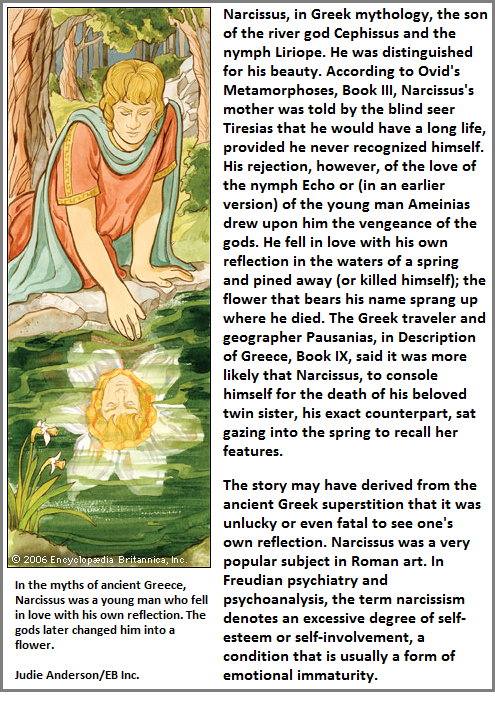
In a 1-2-3 number line, each of these represents a major point of calculation. For example, while we can simply voice the words in term of mimicry without having a corresponding association to quantity, in terms of an actual counting sequence in which such a pairing is taking place. the value "1" is a milestone of achievement for a primitive being without such a reference prior to this model of conceptualization. Such a person might even think of such a realization as a revelation, as a gift from a god... or that they stumbled upon some vast hidden secretive language. However, that is where their... let us say "level" of conceptualization stops. In fact, it is the 1st actual stop in a sequence of numbers that is to be counted, unless one counts the time before any such count began... meaning that cognitive activity was at a stopping point and then started... again, at the value of one. Whichever way you want to look at it, I will at this point count the stop after the value one as the first stop. Then, sometime later, by chance or otherwise, the concept of "2" arose as that greater than the one, even if it was merely thought of in the sense of "another" one (or oneness), as an animal might do upon seeing their reflection, like Narcissus. However, if a person sees the "one" as a representation of themselves, they may not want to make a reflection of it, for fear it would be lost or stolen in terms of either the old Greek superstition, or the later version of some primitive thinking their soul is stolen by a photograph or the Amish view that photographs in which they can be recognized violate the Biblical commandment, "Thou shalt not make unto thyself a graven image", though I think others interpret this expression as referring to the production of a graven image representing god... and not the idea that humans are actually made in the image of (a) god. Silly superstitions (and taken much to seriously) abound everywhere. (How the Amish Feel About Photographs)
The language of mythology is strong. So is the language of superstition and its counterpart called religion. No doubt the genesis of multiple serious subjects today began in some superstitious... magico-religious ideology in the deep past. Yet, why doesn't humanity grow out of such ideas and progress forward into some idealized maturity, wisdom and intelligence? Why don't they grow up? Why do most adults grow out of childhood games or, take the basic patterns of such games and recreate them into some adult production of consciousness which acts out such patterns with different labels and in different contexts? Why can't most of us see such patterns, nor recognize that many of the patterns used by so-called modern peoples are little different in the exercise of basic patterns used by distant human relatives? Why is though we have complex ideas in different subjects, but not everyone can learn them and those who have a good grasp of them, are not only unable to teach the rest of humanity or to be able to apply such supposed advanced thinking to all walks of life as a means of initiating the need for everyone to practice such patterns so that at some future time, such patterned-ideas will become second nature? Why is it that many of us would not think to look upon the babbling of infants and wonder if it is changed from thousands of years ago and whether it will change in years to come... not by way of creating an artificial intelligence placed into some bionic-like infant frame, but as a result of present humanity having an evolutionary change in its cognitive structuring?
Analogously, when speaking of calculations, a triplet code in DNA is a major calculation which Nature espouses. It does this same thing when it uses a "3" repetition in particle physics as a major theme of structure and/or functionality. A "2" repetition to be viewed as a major calculation is that seen in Nature's use of two germ layers (Endoderm/Ectoderm) in Diploblastic life forms. A major "3" calculation is in the Triploblastic life forms with an Endoderm- Mesoderm- Ectoderm.
While the presence of a three-Germ layers design is viewed as being more complex than a two-Germ layers design, and one might even venture to say that the animal life form know as the sponges might be used as a close candidate for representing a one-Germ layer design; this does not automatically mean that human cognition follows a similar 1-2-3 developmental design, but I view it as a possibility and use it as a running hypothesis that this may well be the case. As such, when we identify cognitive orientations which express the enumerations of 1- 2- 3 or simply 1- 2, or 2- 3 such as we find in philosophy; it is of value to review developmental counting and pay witness to the starts and stops as well as cumulative references which may occupy a given "level" of enumeration, such as in the case of using the word "many" to describe "3". Hence, one might encounter the 3-part phrase "one- two- many" not only as an overall expressed cognitive limit to the entire ensemble (or set), but also to the third placed marker... suggesting no major "3" calculation has been cognitively attained. Indeed, we might want to suggest that the usage of a comma after the 3rd value in a values notations lineup is an expression that a cognitive limit has been reached and we have resorted to repeating ourselves. For example, we have ones- tens- hundreds grouped as a set after which we place a comma in order to begin a new set-of-three as a repetition of this pattern.
Here are some games exhibiting a 3 -to- 1 ratio pattern:
- Baseball: 1st, 2nd, 3rd base... there is no fourth base. We say "Home-base" or Home Plate"
- Football: First three downs dominated by running and passing the ball, the 4th down is were the kicking option comes into play as a means of not only giving the ball up, but putting it up for grabs if the other team lose the opportunity to retrieve it.
- Four Square: (2, 3, or 4 players can participate). With four players, the 3 -to- 1 is exhibited with one of the players being the server-of-the-ball. Each player gets a turn, so long as they are not out.
- Chess and Checkers: While the typical moves of playing pieces is horizontal, vertical or horizontal, the additional 4th move is when a playing piece is captured by the opposing player.
Let me... in passing... reference the view that cuss words are sometimes called 4-letter words... and they exhibit 3 consonants to 1 Vowel.
There are multiple examples, with a few to be found here: 3 -to- 1 ratios page A
|
There are other variations of this 3 then 1 sequencing event. Sometimes we do it only with words. For example, the following cheer is representative: (Three lines are the same and follow one another in succession, while one line is different.)
|
|
Another 3 -to- 1 ratio example, which came to mind was that connected with the "Hokey-Pokey" (Hokie-Pokie) song: (This variation is more elaborate in construction than the preceding one.)
Above three -to- one ratio followed by another set of three:
|
|
Another 3 -to- 1 ratio variation can be seen is in the "Happy Birthday" song. Three lines are the same while 1 is different:
|
While sine examples repeat the first three lines to make the 3 -to- 1 ratio stand out, other instances might be difficult to see such as in naming the types of Armed forces the U.S. government has. While some may say: Air Force- Army- Marines- Navy, another might say that the Marines are part of the Navy. Hence, the 3 -to- 1 ratio can only be acknowledged by taking into account both ideas. Another example is the view by some who say there are 4 nucleotides to DNA and RNA. However, if you itemize them side by side or in some relative close proximity (one atop another), we can see that there are three repeating ones for both DNA and RNA, while each of these have an additional "1" singular difference. In addition, as another example in this ball camp, there are 3 stop codons and 1 start codon as well as a 3-to-1 ratio in Mendelian genetics (Biology as Poetry... Mendel's 3 -to- 1 ratio.).
| DNA | RNA | 3 to 1 ratio of nucleotides |
| 2-stranded | 1-stranded | |
| Adenosine | Adenosine | Three the same |
| Cytosine | Cytosine | |
| Guanine | Guanine | |
| Thymine (odd man out) |
Uracil (odd man out) |
One is different |
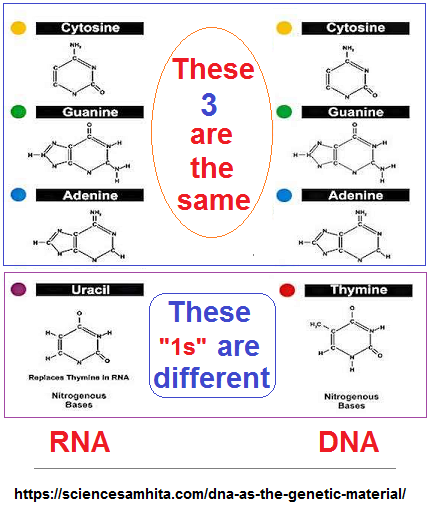
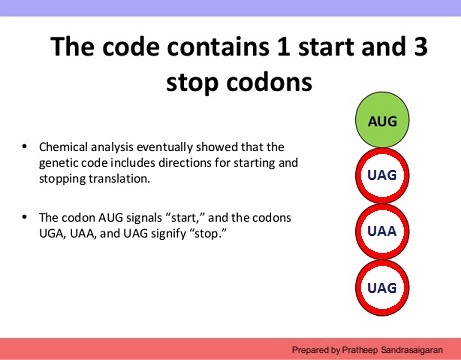

With respect to hearing, since we are also looking at the type of language involving sound, I came across the following three -to- one ratio example:

The point about illustrating examples of what I think are describing an overlooked 3 -to- 1 ratio, is that we need to reassess if what we are describing as a "four" is actually a 3 + 1 mode of counting language. This also encourages us to reconsider numbers like five which might serve us better if we view it as a 2 + 3, or a 3 + 1 + 1. By using a "4" and "5" (etc.,) count, what we are actually describing is a cognitive activity of compartmentalization and condensation. Saying the words "Three Plus (or "and") One" is more burdensome than simply saying the singular "four". Does Nature count 1- 2- 3- 4- etc., or in a 1 -2 -3 (repeat) fashion?
Looking at only one or two examples of the 3 -to- 1 ratio pattern may be cause for some to dismiss it as an irrelevancy, but multiple examples from different subjects suggest the human brain is involved with an exercise that is predominantly ignored by the consciousness of most people, until the pattern is shown. While we may not know what it means (if anything other than a curio like the Fibonacci series), we should at least be able to say we are aware of it.
However, the situation may not be as simple that we are dealing with just a different interpretation... just a different vantage point of the same material. If we consider the view that there are at least two or three functional entities in multiple subjects that one may simply add to a list of other "three" patterns (call the triads, thee-patterned sets, triple structures, sets-of-three, etc...), why is it so difficult for us to consider we may be dealing with three dialects of one language, three languages, or even three cognitive states trying to emerge unto themselves? Whereas we have the ideas of:
- 3 types of consciousness: subconsciousness, consciousness, super-consciousness
- 3 body shapes: endomroph- mesomorph- ectomorph
- 3 sections to the brain: reptilian- mammalian- neo-mammalian
- 3-lettered blood typing (ABO and combinations),
- 3 patterned anatomy: List of threes in human anatomy
- 3 character word order: Subject- Object- Verb (in a musical chairs format)
- 3-patterned dominant structure in physics (along with 2's)
- 3-patterned view of Indo-European cultures (Dumezilian Trifunctional system)
- 3 monument exhibiting a 3-languages grouping (Rosetta stone- Behistun Rock Formation, Galle Inscription)
- 3-fingered usage to hold a pen or pencil
- 3 sentence ending punctuations (period- question mark- exclamation point)
- etc...
For some reason the idea that our cognitive activity has three dominant dialects or a 3-language system or that there is 3 types of cognitive activity working sometimes simultaneously or in an overlapping manner or as intermittent personalities making themselves known; is an idea that is not common parlance. We humans, at least as far as I have as yet ascertained in my experiences, have not developed an idea involving three types of languages taking place when thinking. While it may seem to be an unusual idea, it is not without some precedence that I consider it. Since there are multiple ideas of other 3-patterned physiological, psychological, biological and ideological constructions, there is no reason not to consider the possibility that the mind routinely works with three different cognitive languages or that there are not three types of cognitive activity taking place, even if we are not individually or culturally aware of such. Just because a culture is not aware of Germ Theory or Chemistry, or Mathematics, (etc...) doesn't mean such creatures don't exist in some rudimentary fashion within the brain of humans. Since all formal and serious academic subjects began as some fledgling nuance which continued to grow, this situation may also exist in terms of evolutionary processes taking place... so long as we don't try to "normalize" (prune) them according to some standard of thing which creates an artificial end-product of little Natural values in its own right.
Whereas we can distinguish between letters and numbers, types of math problems, academic disciplines, etc., the idea that we are dealing with more than one cognitive activity jumbled together in an undisciplined manner seems a ludicrous suggestion? Whereas we create systems to differentiate between atomic particles, species, and even multiple dichotomies such as the yin/yang system of decoding perceptions by ordering them into a two-part nomenclature like that used in Biology (as well as the dichotomization of patterns seen in illusions); and use three-part systems for other subject matter... along with a five-part "Pentadactyl" model for comparing the anatomy of different vertebrates; why not consider the presence of repeating cognate languages seen by using a numerical indexing? Whereas in the past the accumulation of different life forms called for some system of differentiation, does not the repetition of numerical patterns though there is but a handful being used over and over again by all humans... and if the analysis of counting limits seen in animals is correct, then they too can be part of the differentiation.
Though it is by tradition we call someone working with numbers a "Numerologist" and assign a given definition to them, what then of those who do not use numbers in a labeled Mathematical way, yet do not fit in any pre-labeled definition? What does it say when a brain uses a small set of numbers, or a small set of number organizational patterns to express themselves with? What is the activity of the brain saying in such cases that the typical verbal languages are not speaking of? Is it merely a mixture of this and that referencing all for little more than some survival impetus? In other words, our web of words is little different than the webs created by spiders, the burrows created by antlions or beneath ground dwelling animals and insects? And if humanity should one day live off the Earth, will a new species arise to begin a new model of that, only to eventually ask the same questions till the Universe implodes, explodes or both?
In this Narrative of Language I am presently engaged as an intellectual sojourn, there are many paths that a person might take away from the conventions of landscape being uttered by those who are called Linguists and have decided to collaborate on a singularly distinctive interpretation of what Language is and which is the best way to approach a study of it. However, if you stray off the path that they set forth as the gospel of their religion with its high priests and groupies of language theorists, you have to be able to provide some rational explanation of why you have and how is it to either support, refute or somehow change the road of "Languating", an perhaps from some perspectives, why you must coin some word which is foreign to the vocabulary already in place. I do so just for fun. "Languating" means I'm messing around with the different ideas and perspectives of language-related ideas and comments in an attempt to discern something that may have been overlooked.
Like a tinkerer in a garage or experimentalist in a lab, or inventor, or someone using a metal detector in the chance of finding some treasure; the term "Languating" means in another (metaphorical) sense I am gathering a group of different musicians (ideas) together to have a makeshift jam session to see if anything of value transpires... (and someone may dream about getting a recording of). Yep, there's probably several ways one might describe the process I am involved with in the present Narrative, including the usage of one or another disparaging analogies... perhaps only because they never liked playing in a sandbox or making castles on a beach or try to build a tree-house, or clubhouse, or get the neighborhood kids together to have a mini-Olympics or create an elaborate string -and- cup communications system in one's yard, or pursue the making of a time machine or develop a new breed of plant, and multiple other exercise of playing that I did as a kid. It is a point of view I still haven't "grown out of". (And yes, I did engage in all the examples and more in childhood. In fact, upon meeting up from my youth, the first thing he wanted to know is about my "threes" idea... to whom I gave a copy of my threes poster.)
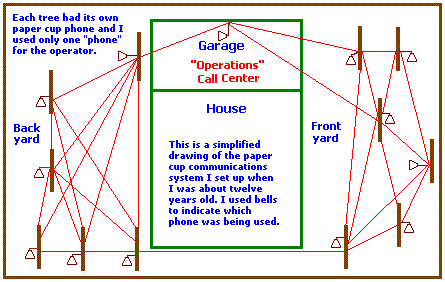
I provide an image I created from the memory I have about the paper cup -and- string phone system I created in my yard as a child, years before the idea of a "call center" ever became a common idea as a business model. The number of phones and trees is accurate, though the image does not give any actual detail of the real garage, landscape and trees. However, it suffices to illustrate the type of language my mind was speaking with... the only problem is, there was no one around to listen and my ideas were far too elaborate for the typical mindset and interests of the neighborhood kids. Yep, I was a proverbial "weird" kid with strange ideas, though many of the straight A academic students liked me... but I was much too impoverished to live and play in their social circles.
It is of need to note that when I am speaking of "calculations" in the present context without referring to an explicit Mathematical one, I am referring to a "cognitive calculation" framed in the manner of a labeled specificity of cognitive position or positioning having been reached, whether or not the algorithm of underlying mental processes is understood. For example, in a primitive counting setting a primitive having obtained a conscious realization that a single object, feeling or idea... however identified symbolically as "1"; is the calculation having been achieved, regardless if you and I can count to 2, 3 and more. Whatever processes and by whatever route was taken to get to the one is the algorithm, and the result is the calculation. I am not viewing the process as a "calculation process" aka (also known as) algorithm. The primitive is calculating (or has calculated) that 1 item refers to a quantity of 1. Similarly, we do not know the exact mental processes involved in a creative process of thinking, though many have created what the believe to be is a rough outline of observable steps in which the mind works (in relation to the rest of the physiology and environment) develops the necessary formative equation from which the calculation (creative expression) is achieved.
Whether the process for an individual is a rough approximation of the process experienced by the whole of the species, is anyone's guess. However, the use of an enumeration model may advantage us in an attempted understanding thereof, unless numbers are too crude a representation, and we await some other means of labeling and interpretation to get us through the morass which verbal languages are presently engaged with finger-painting about because it doesn't know how to sketch or draw by numbers. It knows well how to color by numbers, but it is on the level of finger-painting.
For example, while I have mentioned that it appears the same 1-2-3 cognitive trend encapsulated the Chinese (representative Eastern) mind as it did the European (representative Western) mind, albeit at different times with different embellishments and executions of illustration, it should be pointed out that the Chinese variation took place long before such a cognitive disposition took hold among Europeans. Whereas the Chinese developed a two-patterned ying/yang model of conceptualization (philosophy using objects of nature) attendant with an exercised artistic flair called calligraphy; while the eventually arising two-patterned form of observations got a firmer grip in the conceptual framework activity of Europeans; the use of numbers (by way of a philosophy using numbers) gained a greater threshold ascendancy of importance, from which later arose mathematics that came to later divorce itself from philosophical speculations to form more concrete generalizations adapted to non-artistic, non-immutable expressions through the use of singular lines and in some cases, circles or dots. What was needed and valued were strict representations of values that did not rely on the imagination of different individuals whose sense of value was aligned with the vagaries of emotion or altered perceptions based on experiences which permitted values to be changed according to mood or daily suppositions as one might use when describing a piece of art or fragrance or personal disposition.
Attempting to discern the differences in cognitive development related to those subjects which transpired in Europe as opposed to Asia and elsewhere, there are multiple considerations which may have caused the situation. At present I am leaning towards the difference between tonal and non-tonal languages. It is an idea which came to mind a short while ago and from which spurred the following image which was posted on the present Home page of this site on 11/28/2022:
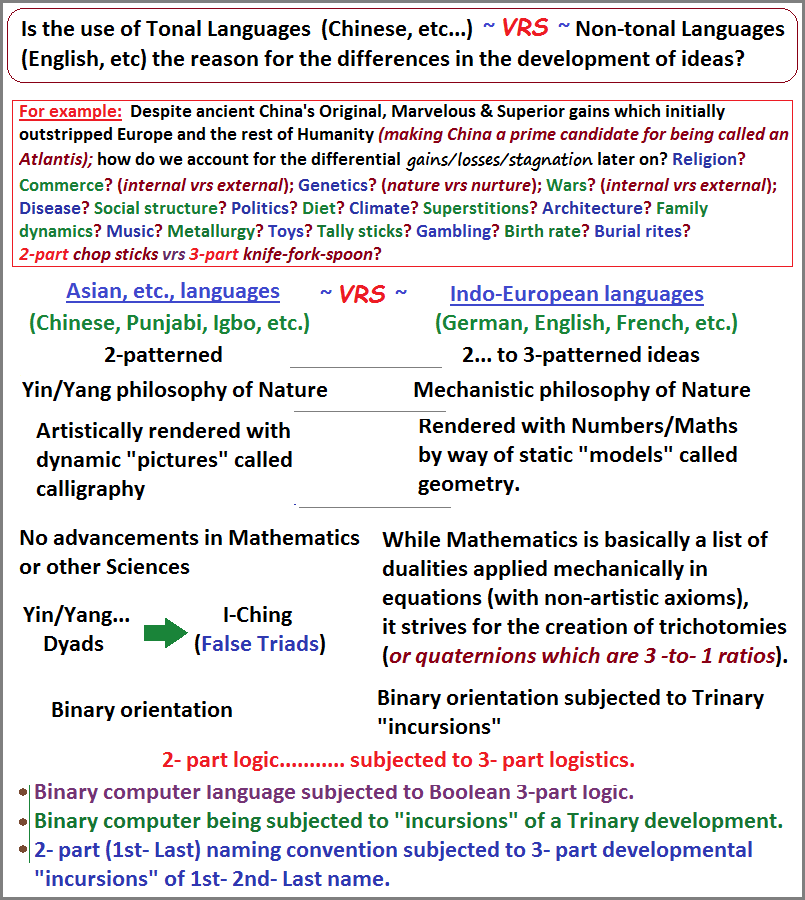
On this page:Tonal or non tonal language? The difference has to do with climate., I found the following comment regarding the terrain differences between tonal and non-tonal languages origins:
The intonation with which a sentence is pronounced is a key element of communication, indeed it is as crucial as the meaning of the sentence itself. In Italian, for example, as with most of the languages spoken in Europe and the Americas, the same sentence can be a question or a statement based purely on intonation. In some languages, tone is extremely important, and the meaning of a word can change completely depending on how it is pronounced. When this is the case, we are dealing with a tonal language. Getting the tone just right in these countries is therefore essential to make oneself understood, and it seems that climate has an influence on this.
In support of this hypothesis, researchers from the Max Planck Institute for Psycho-linguistics, Evolutionary Anthropology and Mathematics in Leipzig (Germany) analysed 3,750 languages from different linguistic families. According to their findings, tonal languages are primarily concentrated in humid environments such as those found in the tropical areas of Subtropical Asia and Central Africa. The explanation is physiological: higher humidity levels lubricate the mucous membranes of the vocal folds and change their balance, making them more elastic and functional so that they can oscillate more freely and produce a wider range of tonal pitches.
Let us look at the idea of "tone" in terms of language from : ("tone." Encyclopædia Britannica. )
Tone in linguistics, (describes) a variation in the pitch of the voice while speaking. The word tone is usually applied to those languages (called tone languages) in which pitch serves to help distinguish words and grammatical categories—i.e., in which pitch characteristics are used to differentiate one word from another word that is otherwise identical in its sequence of consonants and vowels. For example, man in Mandarin Chinese may mean either "deceive" or "slow," depending on its pitch.
In tone languages, pitch is a property of words, but what is important is not absolute pitch but relative pitch. Tone languages usually make use of a limited number of pitch contrasts. These contrasts are called the tones of the language. The domain of the tones is usually the syllable.
There are two main types of tone languages:
- Register-tone (or level-tone): Register-tone languages use tones that are level; i.e., they have relatively steady-state pitches, which differ with regard to being relatively higher or lower.
- This is characteristic of many tone languages in West Africa.
- Contour-tone: In contour-tone languages at least some of the tones must be described in terms of pitch movements, such as rises and falls or more complex movements such as rise–falls.
- This is characteristic of many tone languages of Southeast Asia.
Let us now look at Tone from a Wikipedia article:
- Many languages, including Chinese, Vietnamese, Thai, Lao, Hmong, Punjabi, Sylheti, Chittagonian, Yorùbá, Igbo, Luganda, Ewe, and Cherokee are tonal.
- Other languages, including Indo-European languages such as English and Hindi, are not considered tone languages. They can use Intonation (linguistics) in different ways.
- In some languages, it is pitch accent that is important instead. A word's meaning can then change if a different syllable is stressed. Examples include Ancient Greek, Hebrew, Swedish, Norwegian, Serbo-Croatian, Lithuanian, and some Asian languages like Japanese and Korean. However, pitch accent is different from tones.
Date of (series) Origination: Saturday, 14th March 2020... 6:11 AM
Date of Initial Posting (this page): 9th January 2023... 12:1 AM AST (Arizona Standard Time); Marana, AZ.